abit IP35-Pro: Houston, We Have a Winner
by Gary Key on November 1, 2007 7:00 AM EST- Posted in
- Motherboards
abit IP35-Pro: Board Layout and Features
The abit engineers spent the proper amount of time on the layout of this board. The color scheme is simple and almost elegant when comparing it to some of the Crayola color schemes we have seen in the labs. The board was a snap to install in our Antec P180 and Cooler Master 830 cases with most connections easily reached. The board features a high quality four-phase voltage regulator system that provided excellent stability throughout testing. The board also utilizes Conductive Polymer Aluminum Solid Capacitors.
The IP35-Pro comes with six fan headers (1 x 4-pin, 5 x 3-pin) that provided an excellent balance of cooling options. Control of the individual fan headers is available via the BIOS and the µGuru program within Windows. Each header type has the three options of monitoring and control settings within the BIOS. abit utilizes a well-engineered heat pipe system for cooling the MCH, ICH, and PWM component areas.
Engineering can only take you so far, and unfortunately the execution is not always up to standards. Out of the three boards we tested, two had problems with the heatsink properly making contact on the PWM components and the MCH heatsink was not completely flat. A quick Google search will lead you to a forum user who "fixed" this problem. We tried it on one of our boards and noticed the MCH temperatures dropped 5C while PWM temperatures dropped over 9C when overclocking the board.
Around the CPU socket area, we find an ample amount of room for the majority of cooling solutions. We utilize the stock heatsink/fan in our base testing but also installed several aftermarket Socket-775 cooling solutions such as the Tuniq 120 and Thermalright Ultra 120 eXtreme during our overclocking tests. However, based upon our initial overclocking tests, if a vertical mounted fan in an air cooling unit such as the Tuniq 120 or water-cooling is utilized then additional air cooling will be required on the MCH and PWM areas. In other words, the heat pipe system works best with a downward blowing CPU HSF fan in mind.
The 8-pin ATX power connector is located on the edge of the board behind the PS/2 ports and did not interfere with our various cooling units. It is easy to remove the heat pipe system if you wish to water cool the MCH/ICH chipsets or perform the PWM heatsink mod.

The DIMM module slots' color coordination is correct for dual channel setup based upon the premise of installing DIMMs in the same colored slots for dual-channel operation. Installing memory modules will not be a problem, even with a full-size video card in the first PCI Express x16 slot. The 24-pin ATX power connector is located on the edge of the board along with the number three system fan header.
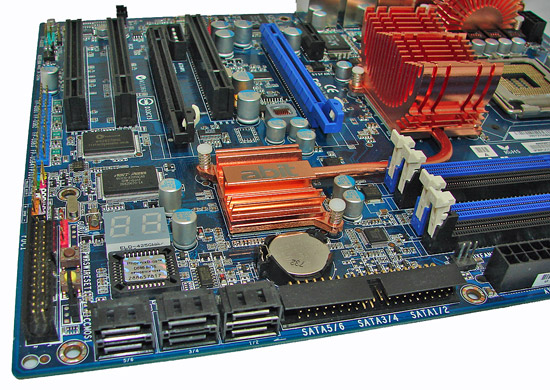
We found the positioning of the six black ICH9R SATA ports to be excellent when utilizing the expansion slots, as they are out of the way of most long cards. The ICH9R chipset uses passive cooling and was reasonably cool to the touch throughout testing. To the right of the SATA ports is the IDE connector and battery.
In a nod to those users who run their systems on an open platform or get tired of hooking up the chassis panel connections, abit has added power on and reset buttons on the board. These buttons have always been useful for us and should be standard on any board in this market segment. Of course, a POST Code Debug LED is included in typical abit style and the floppy drive connector is located next to it.
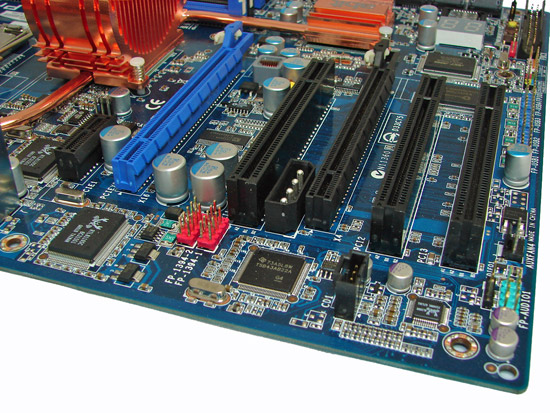
The board comes with two physical PCI Express x16 connectors (1 x16, 1 x4 electrical), one PCI Express x1 connector, and three PCI 2.3 connectors. A dual slot graphics card will block the second PCI slots. Several cards we tried in the PCI Express x1 slot had a tight fit with our 2900XT card installed. A 4-pin 12V Molex connector is to the right of the first PCI slot; CrossFire configurations (or systems where all of the expansion slots are populated) should use this extra power connector.
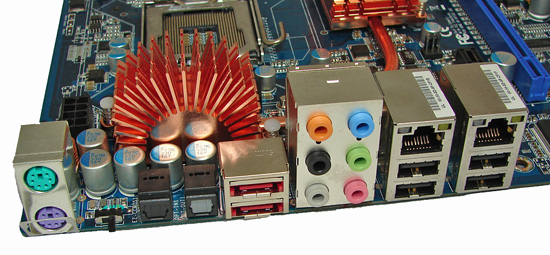
The rear panel contains the standard PS/2 mouse and keyboard ports. The panel also includes two RJ-45 LAN ports with activity indicator lights, four USB ports, and optical in/out S/PDIF ports. The audio panel consists of six ports that support 2, 4, 6, and 8-channel audio connections for the Realtek ALC888 HD codec. Finally, there are two eSATA ports along with a handy clear CMOS switch.
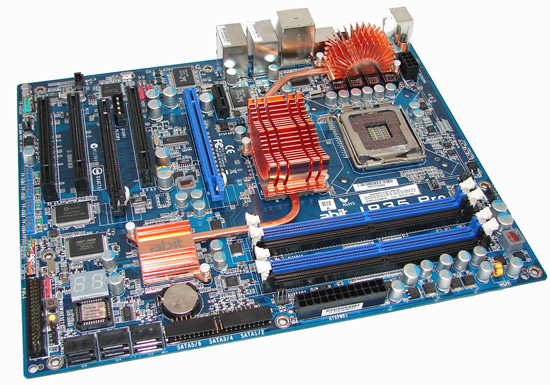 |
The abit engineers spent the proper amount of time on the layout of this board. The color scheme is simple and almost elegant when comparing it to some of the Crayola color schemes we have seen in the labs. The board was a snap to install in our Antec P180 and Cooler Master 830 cases with most connections easily reached. The board features a high quality four-phase voltage regulator system that provided excellent stability throughout testing. The board also utilizes Conductive Polymer Aluminum Solid Capacitors.
The IP35-Pro comes with six fan headers (1 x 4-pin, 5 x 3-pin) that provided an excellent balance of cooling options. Control of the individual fan headers is available via the BIOS and the µGuru program within Windows. Each header type has the three options of monitoring and control settings within the BIOS. abit utilizes a well-engineered heat pipe system for cooling the MCH, ICH, and PWM component areas.
Engineering can only take you so far, and unfortunately the execution is not always up to standards. Out of the three boards we tested, two had problems with the heatsink properly making contact on the PWM components and the MCH heatsink was not completely flat. A quick Google search will lead you to a forum user who "fixed" this problem. We tried it on one of our boards and noticed the MCH temperatures dropped 5C while PWM temperatures dropped over 9C when overclocking the board.
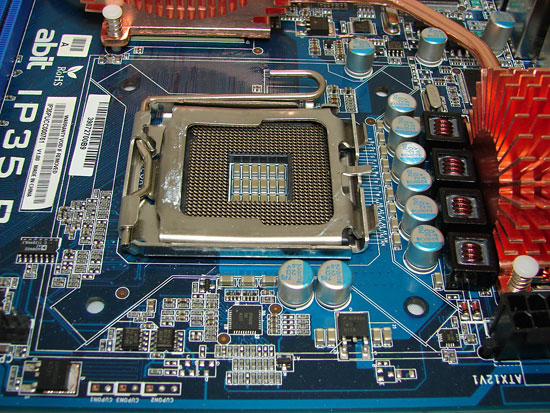 |
Around the CPU socket area, we find an ample amount of room for the majority of cooling solutions. We utilize the stock heatsink/fan in our base testing but also installed several aftermarket Socket-775 cooling solutions such as the Tuniq 120 and Thermalright Ultra 120 eXtreme during our overclocking tests. However, based upon our initial overclocking tests, if a vertical mounted fan in an air cooling unit such as the Tuniq 120 or water-cooling is utilized then additional air cooling will be required on the MCH and PWM areas. In other words, the heat pipe system works best with a downward blowing CPU HSF fan in mind.
The 8-pin ATX power connector is located on the edge of the board behind the PS/2 ports and did not interfere with our various cooling units. It is easy to remove the heat pipe system if you wish to water cool the MCH/ICH chipsets or perform the PWM heatsink mod.

The DIMM module slots' color coordination is correct for dual channel setup based upon the premise of installing DIMMs in the same colored slots for dual-channel operation. Installing memory modules will not be a problem, even with a full-size video card in the first PCI Express x16 slot. The 24-pin ATX power connector is located on the edge of the board along with the number three system fan header.

We found the positioning of the six black ICH9R SATA ports to be excellent when utilizing the expansion slots, as they are out of the way of most long cards. The ICH9R chipset uses passive cooling and was reasonably cool to the touch throughout testing. To the right of the SATA ports is the IDE connector and battery.
In a nod to those users who run their systems on an open platform or get tired of hooking up the chassis panel connections, abit has added power on and reset buttons on the board. These buttons have always been useful for us and should be standard on any board in this market segment. Of course, a POST Code Debug LED is included in typical abit style and the floppy drive connector is located next to it.

The board comes with two physical PCI Express x16 connectors (1 x16, 1 x4 electrical), one PCI Express x1 connector, and three PCI 2.3 connectors. A dual slot graphics card will block the second PCI slots. Several cards we tried in the PCI Express x1 slot had a tight fit with our 2900XT card installed. A 4-pin 12V Molex connector is to the right of the first PCI slot; CrossFire configurations (or systems where all of the expansion slots are populated) should use this extra power connector.

The rear panel contains the standard PS/2 mouse and keyboard ports. The panel also includes two RJ-45 LAN ports with activity indicator lights, four USB ports, and optical in/out S/PDIF ports. The audio panel consists of six ports that support 2, 4, 6, and 8-channel audio connections for the Realtek ALC888 HD codec. Finally, there are two eSATA ports along with a handy clear CMOS switch.










29 Comments
View All Comments
Crafty Spiker - Sunday, July 27, 2008 - link
This board should be called the Catch-22. I'm on my 4th day and 2nd chassis (and peripherals) trying to find some combination of hardware that this piece of crap will handle properly.Catch #1: Trying to get an LSI SCSI RAID card and a Promise SX4000 to work at the same time. Far as I can see, can't be done. No diagnostic messages at all. Great BIOS engineering
Catch #2: Tried a smaller rig - just one Adaptec SCSI RAID card. Won't work at all.
Catch#3: IDE does not work. The BIOS sees the attached devices but the OS won't/
Catch #4: Digital audio output is optical ONLY. How do you spell "reconfigure the home theater"?
Catch #5: the onboard NIC's are crap. Won't do 9KB jumbo frames.
All in all I'd say that unless you are doing a completely dirt simple build that you look elsewhere. And reviewers should look a bit more carefully at what they're reviewing.
Dacalo - Wednesday, December 12, 2007 - link
I notice that under Bios UGuru, your screen shows 1.25V. Mine MB's lowest option is only 1.3175(?) around there. I thought this was odd. Do you think it's because I have older BIOS?Cybertori - Friday, November 9, 2007 - link
I have one of these boards, and its been very good and reliable. Works with my new dual-core CPU, the BIOS is amazingly accomodating, and no problems whatsoever. This is my first purchase of an Abit product, but I am impressed. CPU and MB temps have been very cool, even under load, so I'd have to say the passive cooling is working well. Apart from the placement of some connectors, a really good motherboard - one of the best available for Intel processors, and a good value too.Zak - Monday, November 5, 2007 - link
A couple of years ago I had so many problems with abit mobos (and MSI by the way), like 4 lemons in a row, that I will never ever touch their mobos no matter what they do, my distrust for their quality is too deep. I'll stick to Asus (despite their horrible support) and Gigabyte.Zak
MichaelD - Friday, November 2, 2007 - link
So, there's a "trick" or "tweak" that fixes a deficiency and makes the board more stable and reliable...yet you don't tell us what that is? Why not just link directly to the webpage showing the fix? OR just TELL US what said fix action is? "A quick Google search" yielded me nothing but other reviews of the board. I could not find the fix. Great article and review, but you fell short by not linking directly to the fix action.
Gary Key - Saturday, November 3, 2007 - link
The hot link was in the article if you mouse over "user" - but here it is in case that does not work - http://www.xtremesystems.org/forums/showpost.php?p...">http://www.xtremesystems.org/forums/showpost.php?p... .Shimmishim - Friday, November 2, 2007 - link
This board has been out since about July? X38 reviews have been popping up all over the web. Anyway.I've owned this board for over 3 months now and it has been one of my all time favorite boards. It o/c's 4x1GB of ram very nicely and quadcores (with a bit of tweaking).
Bozo Galora - Thursday, November 1, 2007 - link
for those who cant wait another month for AT to achieve a good enough review so as not to threaten ad revenues - here's a fairly good overview from Tomshttp://www.tomshardware.com/2007/10/31/x38_compari...">http://www.tomshardware.com/2007/10/31/x38_compari...
goinginstyle - Saturday, November 3, 2007 - link
You are an arse. I have not seen any ads on AT with abit so that blows your statement. Also, they had the one of the first X38 previews on the web and at least they are doing the reviews right instead of some photos and a couple of tests while declaring any and all boards to be the greatest. AT's X38 launch article was the only one that told the truth about this not ready for prime time chipset. I guess they did that to improve ad revenues in your book.
Anonymous Freak - Thursday, November 1, 2007 - link
I mean, who doesn't have a router nowadays? Even goofier are the boards with Wi-Fi and "built-in routers". Call me old fashioned, but I actually want my router separate from my PC.What I want is a micro-ATX board, dual PCI-E x16 slots, (not that I actually expect to use SLI/CrossFire anytime soon, but what if I want to slap a RAID card in there?) onboard "HD Audio" with optical in and out, eSATA, onboard FireWire on the backplane (some of us still use FW camcorders,) and ONE Gigabit NIC. No need for a second, really.
Is that too much to ask?
It's like they now equate "enthusiast" with dual NIC. (A few years ago, before decent Wi-Fi routers could be had for http://shop1.outpost.com/product/3635275">less than $30, it might have made sense. But not any more. There are even http://shop1.outpost.com/product/5117566">multiple http://shop1.outpost.com/product/4832150">under http://shop1.outpost.com/product/4863030">$100 http://shop1.outpost.com/product/5232917">802.11n http://shop1.outpost.com/product/5284527">wireless http://shop1.outpost.com/product/5192516">routers.